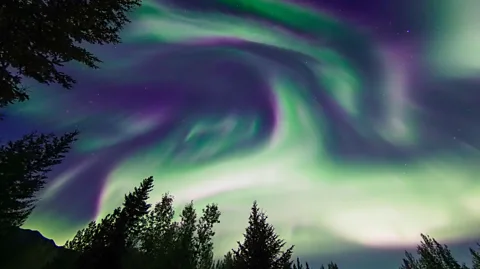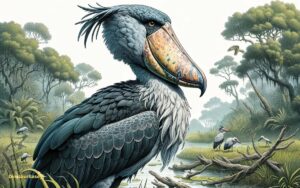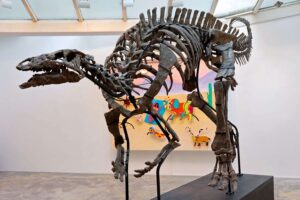What are Dinosaur Fossils: Unveiling Prehistoric Secrets
Dinosaur fossils are preserved remains or traces of prehistoric dinosaurs. These ancient remnants, discovered in rock formations, date back millions of years.
Fossils provide a window into the past, offering insight into the diverse species that once roamed Earth. They range from full skeletons to single bones or teeth, and even include impressions of skin or feathers. As a record of biological evolution, dinosaur fossils play a vital role in our understanding of natural history.
Unearthing these fossils requires meticulous paleontological methods, often involving careful excavation and detailed analysis. Scientists use them to reconstruct the appearance, behavior, and environment of the creatures that once dominated our planet. The study of dinosaur fossils not only fascinates the scientific community but also captivates the public, fueling a perennial curiosity about these ancient animals and their ecosystems.

Credit: www.ebay.com

Dinosaur Fossils Unearthed
Imagine a world millions of years ago, filled with incredible creatures. Dinosaurs roamed the Earth in all their might and glory. Today, we have a window into that distant past: dinosaur fossils. These fossilized remains provide crucial evidence of the dinosaurs’ existence, behaviour, and evolution. Unearthed from layers of rock, each fossil tells a fascinating story of a world long gone.
The Fossilization Process
Fossilization is a rare event that occurs over millions of years. It starts when a dinosaur dies and its body settles into mud, silt, or sand. Over time, this sediment hardens and turns into rock, enclosing the bones. Minerals seep in, replacing the organic material, preserving the bones as rock-like fossils. This natural process gives us durable evidence of prehistoric life.
Types Of Dinosaur Fossils Discovered
- Body Fossils: Actual parts of the dinosaur, like bones and teeth.
- Trace Fossils: Indications of dinosaur activity, such as footprints and nest sites.
- Skin Impressions: Rare fossils showing skin texture.
- Coprolites: Fossilized dinosaur dung that offers dietary clues.

Credit: www.sciencefocus.com
Significance Of Fossil Finds
Dinosaur fossils are like nature’s time capsules. They give scientists a sneak peek into a world millions of years old. These ancient relics are crucial for unraveling Earth’s deep past. Fossils show what creatures looked like, where they lived, and how they survived. Each discovery can change what we know about life on Earth.
Insights Into Prehistoric Life
Imagine finding a real dinosaur bone! It’s exciting because fossils are clues about prehistoric life. Fossils help us picture dinosaurs and their habitats. They also show what dinosaurs ate and maybe how they acted. Scientists study these fossils and learn about the environment long ago.
- Types of dinosaurs
- Habitats they lived in
- Diet and behavior patterns
Evolutionary Biology And Natural History
Dinosaur fossils also tell us about evolution. They are key to understanding how species change over time. Through fossils, we can track the rise and fall of different creatures. This helps us discover links between past and present life forms.
| Benefit | Explanation |
|---|---|
| Evidence of Evolution | Fossils show how creatures have changed. |
| Species Connections | They reveal links between ancient and modern animals. |
| Understand Extinctions | Fossils explain why some species are not around anymore. |
Excavation And Preservation
Fossil excavation and preservation are crucial in understanding our planet’s prehistoric life. Dinosaur fossils are the remains of these ancient creatures preserved in rock. Experts use special techniques to dig them up and keep them safe. This ensures we can study these fascinating relics for years to come.
Techniques For Uncovering Fossils
To find dinosaur bones, scientists carefully remove earth layer by layer. They use tools like brushes and chisels. The goal is to uncover fossils without damaging them. It’s a slow process but very rewarding. Here are some methods they use:
- Mapping: Scientists create a grid to record where fossils are found.
- Brushing: Gently sweeping away dirt reveals the fossil.
- Plaster Casting: Wrapping fossils to protect them once they’re found.
Maintaining Fossil Integrity Post-discovery
After digging up fossils, the next step is keeping them intact. This process is called conservation. Scientists use special chemicals to harden the fossils. This stops them from breaking. They also keep detailed records of the fossils’ conditions.
- Transport: Move fossils carefully to avoid breaks.
- Stabilization: Apply chemicals to make fossils stronger.
- Storage: Keep fossils in a climate-controlled place to protect them.
Notable Fossil Discoveries
Dinosaur fossils tell us stories from millions of years ago. They help us understand how dinosaurs lived. Paleontologists, who study fossils, have made many exciting discoveries.
Famous Dinosaur Specimens
Some dinosaur fossils stand out from the rest. They became stars in the science world.
- Tyrannosaurus Rex (T-Rex): Sue is the largest and best-preserved T-Rex fossil. You can see it in the Field Museum of Natural History in Chicago.
- Velociraptor: Known from the “Jurassic Park” movies, real Velociraptor fossils show they were feathered and smaller.
- Stegosaurus: Sophie is a nearly complete Stegosaurus and she lives in the Natural History Museum in London.
- Triceratops: One impressive specimen is on display at the Smithsonian National Museum of Natural History in Washington, D.C.
Recent Groundbreaking Finds
New discoveries still wow us today. They offer fresh insights into the dinosaur era.
- In Morocco, paleontologists found Ajnabia odysseus, a duck-billed dinosaur. This showed that these dinosaurs could swim between continents!
- In China, the Yi qi stunned everyone. This dinosaur had bat-like wings and feathers.
- Argentina gave us Patagotitan mayorum, one of the largest dinosaurs ever. It weighed as much as 12 elephants!
These fossils change what we know about dinosaurs. Every find is a puzzle piece in Earth’s history!
Fossils: Beyond The Dinosaurs
The story of life on Earth stretches far beyond the age of dinosaurs. Unearthing the secrets of our planet’s past, fossils provide a window into ancient worlds. These remains tell a tale not just of the dinosaur’s reign but of the myriad creatures before and after them.
Pre-dinosaur Era Fossil Records
Life began long before the mighty dinosaurs. Trace fossils give clues about the pre-dinosaur era. Here’s a peek:
- Stromatolites: These are layers of bacteria and sediment. They are proof of life over 3.5 billion years ago.
- Trilobites: Their remains show diversity over 521 million years ago.
- Ferns and cone-bearing trees: They mark the lush landscapes of ancient Earth.
The Rise Of Mammals And Fossil Evidence
With the dinosaurs gone, mammals took center stage. Many fossils tell us how:
| Period | Fossil Evidence |
|---|---|
| Paleocene | Small creatures evolve into diverse species |
| Eocene | Modern mammal groups appear |
| Oligocene | Grasslands expand, mammals adapt |

Credit: www.bbc.com
Conclusion
Understanding dinosaur fossils offers us a unique glimpse into a past teeming with colossal creatures and transformative events. By studying these ancient remains, we unlock history’s secrets and piece together life’s grand evolutionary puzzle. Embracing the wonder of these discoveries not only fuels scientific inquiry but also ignites our imaginations about the Earth’s incredible prehistoric chapters.
Let’s keep digging deeper into time, unearthing the stories etched in stone from an age when dinosaurs reigned supreme.




